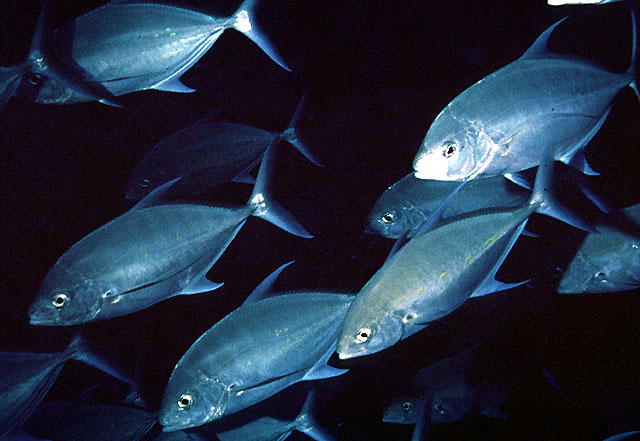| Carangidae (Jacks and pompanos), subfamily: Caranginae |
| 75 cm TL (male/unsexed); max.weight: 6,610.0 g |
|
reef-associated; marine; depth range 0 - 168 m, oceanodromous |
| Indo-Pacific: western Indian Ocean to the Austral Islands, north to southern Japan and Hawaii, south to Sydney, Australia. Eastern Central Pacific: Mexico and the Revillagigedo Islands (Ref. 9283). |
|
Dorsal spines (total): 9-9; Dorsal soft rays (total): 28-31; Anal spines: 3-3; Anal soft rays: 24-26. Description: Brassy to greenish blue dorsally, shading to silvery on sides, adult with 6-7 faint grey bars on dorsal half and several relatively large elliptical yellow spots (often with dusky centers) on middle of side. Body oblong and compressed, dorsal profile more convex than ventral profile. Breast scaleless ventrally to origin of pelvic fins. LL scutes 19-31. Snout usually slightly angular (Ref. 90102). Large individuals develop a terminal snout and elongate points on the soft dorsal and anal fins (Ref. 37816). |
| Adults are pelagic and are abundant around oceanic islands while not found in neritic areas (Ref. 9283, 58302). May be encountered in solitary, pairs or small schools. Schools frequent sandy river basins, sandy channels of lagoon and seaward reefs. Feed on small crustaceans in the sand (Ref. 9283). Marketed fresh and dried or salted (Ref. 9283). Minimum depth reported taken from Ref. 128797. |
|
Least Concern (LC); Date assessed: 09 March 2015 Ref. (130435)
|
| harmless |
Source and more info: www.fishbase.org. For personal, classroom, and other internal use only. Not for publication.
